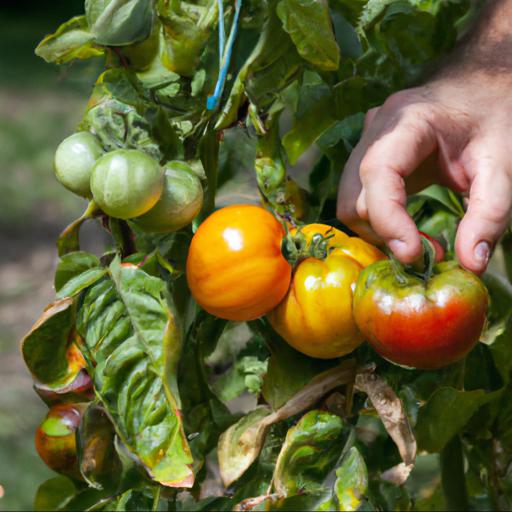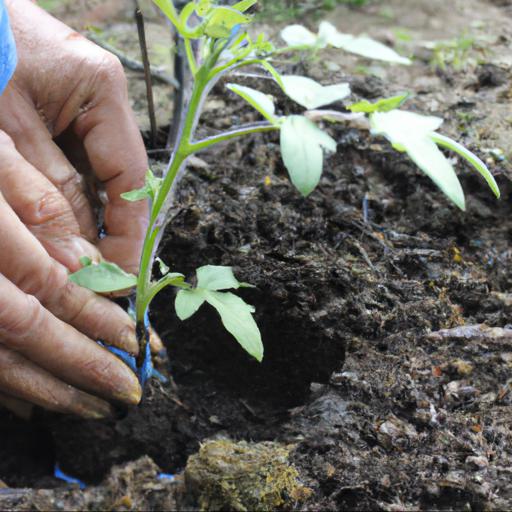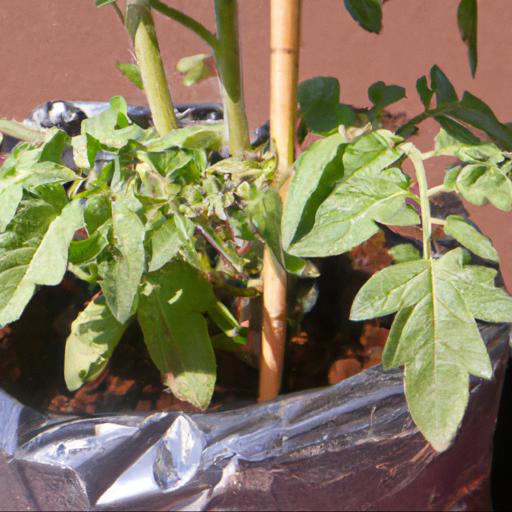Are you a tomato grower looking for ways to save time? Growing tomatoes can be a time-consuming task, but with the right tips and tricks, you can save time and maximize your harvest. In this blog, we’ll share some of our top time-saving tips for growing tomatoes, so you can spend less time tending to your plants and more time enjoying the fruits of your labor!
With these tips, you’ll be able to grow more tomatoes in less time, and reap the rewards of a bountiful harvest.
Preparing the soil for planting tomatoes

-Growing tomatoes can be a rewarding but time-consuming endeavor. That’s why it’s important to follow a few essential but time-saving tips when preparing your soil for planting.
From selecting the right locations in your garden to performing timely soil tests, here are some ideas to help you get the most out of your tomato growing experience this season. One of the most important time-saving tips when preparing your soil for planting tomatoes is to select the right area of your garden. Consider the environment, including sun exposure and soil type.
Tomatoes generally prefer soil with a neutral pH and plenty of organic matter, so be sure to incorporate compost or other amendments accordingly. Additionally, tomatoes need space to spread out their roots, so avoid overcrowding when planting. Next, it’s important to perform proper soil testing.
This includes testing for pH levels, nutrient levels, and soil texture. Knowing the pH in your soil will help you determine which varieties of tomato plants will best suit your location.
Additionally, a proper soil test will alert you to any deficiencies that may need to be amended. These tests can be conducted at most garden centers and should be performed before you begin planting. Finally, timing your planting for peak season will help save you time in the long run.
Tomatoes are best planted in early spring, before the last frost. Typically, wait to sow the seeds until the soil temperature reaches a minimum of 18 °C.
This should ensure that your plants have time to establish a good root system before the sweltering summer heat arrives. Make sure to water your tomato plants regularly and keep the soil evenly moist, especially during dry summers. Following these time-saving tips when preparing your garden soil for planting tomatoes can help you get the most out of your gardening efforts this season. From selecting the right areas for planting to performing timely soil tests, you’ll be well on your way to a rich, abundant harvest of plump, juicy tomatoes.
Choosing the right variety of tomato for your garden

As time-saving tips for growing tomatoes go, it is important to choose the right variety for your garden. With the right variety planted and taken care of, you can have juicy and delicious tomatoes for years to come. So in this article, we discuss how to go about selecting the best variety for your garden.
When it comes to growing tomatoes, there is no one size fits all. Different varieties will require different maintenance and conditions to thrive.
Therefore, it is important to consider your available space, climate, and soil type when making your selection. If you have limited space, opt for a compact variety such as a bush or dwarf tomato.
These can be grown in hanging baskets and small pots, yielding an abundance of tomatoes over the season. For warmer climates, look for varieties that are suitable for balmy summers such as Early Girls and Quick Yield. Colder regions should look to varieties that can withstand frost such as San Marzano and Santiago.
Having considered your climate, you now have to decide on the flavour and texture of your tomatoes. If you rather something sweet, then you should try a variety like Tiny Tim or SugaryTops.
For a more tangy flavour, then Plum Tomatoes are your go-to choice. And for something in between, cherry tomatoes offer a nice balance of sweet and acidic. Added to this, you must also bear in mind which tomatoes are best suited for eating fresh, and which are better for baking and cooking.
Roma and Amish Paste tomatoes are recommended for flavorful sauces, whereas Juice Tomatoes are perfect for salads and snacking. All these considerations, when taken together, can help you choose the right variety of tomato for your garden. Armed with your chosen variety, all that is left is to get planting and caring for your plants. With a little bit of hard work and dedication, a delicious harvest is right around the corner.
Planting and caring for tomatoes

Tomatoes are a popular garden favourite, and luckily for us, they’re easy to grow! With a few time-saving tips, you can have delicious homegrown tomatoes in just a few short months. If you’re short on time, consider starting your tomatoes from seedlings instead of from seed.
This way, you can skip the germination process, which normally takes two to three weeks. Plus, seedlings are generally easier to manage than seeds, so you won’t have to worry about thinning out the crowded seedlings or ruining the delicate roots.
When planting your tomatoes, choose a sunny spot with well-drained soil. Tomatoes need a lot of warmth and require consistent moisture in order to thrive.
Try to water your tomatoes daily, or at least every other day, depending on your local climate. Monitor the soil moisture level often to ensure the water is getting to the roots. Additionally, mulch around the base of the plants to help keep the soil moist and discourage weeds.
Fertilising is another important aspect of caring for your tomatoes. Be sure to add a nitrogen-rich fertilizer throughout the season to encourage healthy growth and abundant yields. Adding a side-dress of compost or well-rotted manure in the spring and again in the summer will help to replenish the soil and provide the plants with essential nutrients.
Overall, with some regular attention, you can enjoy the ultimate reward of a beautiful and bountiful tomato harvest. So get growing and enjoy the sweet rewards of growing your own delicious tomatoes!
Harvesting and storing tomatoes
Harvesting and storing tomatoes can be an enjoyable and time-saving task, with some simple tips and advice from a UK garden expert. Tomatoes are one of the most popular vegetables in Britain and can be eaten in a variety of ways – from sauces and curries, to salads and soups. To make the most of these versatile vegetables, as well as help to save time, here are some top tips for harvesting and storing tomatoes.
Firstly, when harvesting tomatoes, try to do so when they look and feel ripe, but still firm. If you wait too long, they may become too soft and disintegrate on the vine, while picking them too early means they will never reach full ripeness.
You can also save time by picking your tomatoes in batches, grouping together those of similar size, colour and degree of ripeness. When it comes to storing tomatoes, it is recommended to keep harvested tomatoes at room temperature to ensure they will ripen fully. To slow down the ripening process, tomatoes can be refrigerated, but never in temperatures below seven degrees Celsius.
It is also good practice to carefully remove all the stems and leaves from the tomatoes before storing them in the fridge, as this will help to prolong their shelf life. Finally, if you don’t have any room in your refrigerator for large batches of tomatoes, try turning to your freezer.
To do this, first core the tomatoes, then blanch them before freezing. Then, when you’re ready to enjoy them, simply thaw them at room temperature before turning them into your favourite dishes or sauces.
With these time-saving tips for harvesting and storing tomatoes, you can enjoy delicious, homegrown tomatoes all year round!
Conclusion
This article provides time-saving tips for growing tomatoes. It covers topics such as planting in containers, using mulch, and providing adequate water and sunlight.
Additionally, it suggests pruning and staking plants, and removing diseased leaves. With these tips, gardeners can save time and enjoy a successful harvest of tomatoes.
FAQ
What are some easy ways to save time when growing tomatoes?
1. Start with healthy, disease-resistant tomato varieties. 2. Plant tomatoes in a sunny spot with well-draining soil. 3. Use a trellis or stake to support the tomato plants. 4. Mulch around the plants to keep the soil moist and reduce weeds. 5. Water the plants regularly and deeply. 6. Prune off any diseased or damaged foliage. 7. Harvest tomatoes when they are ripe.
What are the best soil conditions for growing tomatoes?
The best soil conditions for growing tomatoes are well-drained, nutrient-rich soil with a pH between 6.0 and 6.8.
What are the most efficient methods for watering tomatoes?
The most efficient methods for watering tomatoes are drip irrigation or soaker hoses, which deliver water directly to the roots of the plants. Additionally, using mulch around the plants can help retain moisture and reduce the need for frequent watering.
What are the best fertilizers for growing tomatoes?
The best fertilizers for growing tomatoes are those that are high in nitrogen, phosphorus, and potassium. Organic fertilizers such as compost, manure, and fish emulsion are also great for tomatoes.
What are the best techniques for pruning tomatoes?
The best techniques for pruning tomatoes include removing any diseased or damaged branches, cutting back any branches that are growing too close together, and removing any suckers that are growing from the main stem. Additionally, it is important to keep the main stem of the plant pruned to a manageable size and to prune off any flowers or fruits that are not needed.
What are the best methods for controlling pests and diseases when growing tomatoes?
The best methods for controlling pests and diseases when growing tomatoes include using row covers, crop rotation, and companion planting. Additionally, using organic pesticides and fungicides, and removing any affected plants or fruits can help to control pests and diseases.

